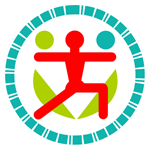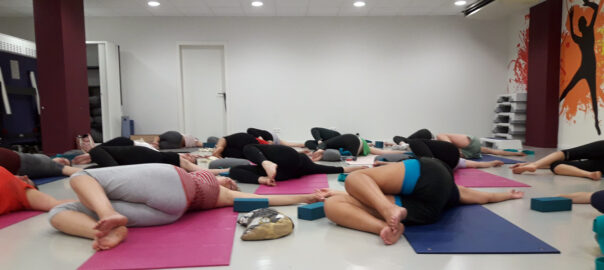Distraction versus relaxation
The yoga class at noon was exceptionally popular that day. All the yoga mats had been handed out, and even the welfare officer in charge who initiated the class had passed his mat on to another colleague.
And just then, another staff member appeared at the doorway, stepping into the class for the first time. When she gathered from the situation that the room was egg-full and no more mat available, she made preparations to turn right around and walk out.
This is sometimes how it goes when you take a step towards something new. As soon as something resembling an obstacle crosses your path, the creature of habit in us is quick to give up immediately.
A pathway to more serenity
The yoga teacher greeted her and the colleague confided to him: “I have been thinking of joining this class for some time, and today I felt like I really need it …”. The deal was quickly struck when the teacher also exceptionally made his yoga mat available.
About an hour later, after a yoga series of concentration, physical and breathing efforts, ending with a final relaxation in flat rest, the staff member in question spontaneously came back and shared her experience.
“We had exceptionally unexpected and demanding situations in our department this morning, and I really thought the building was going to come crashing down on me figuratively. I had to do something to regain my composure. However, I had my doubts because I had no idea exactly what kind of yoga this was going to be. And lo and behold: during that final relaxation, as I lay there on that mat on the floor, it was as if in the depths of me, in all serenity, an agenda was being drawn up automatically. And so I saw step by step how I could resolve this chaotic and unexpected situation. Everything fell into place. Thank you for this hour!”
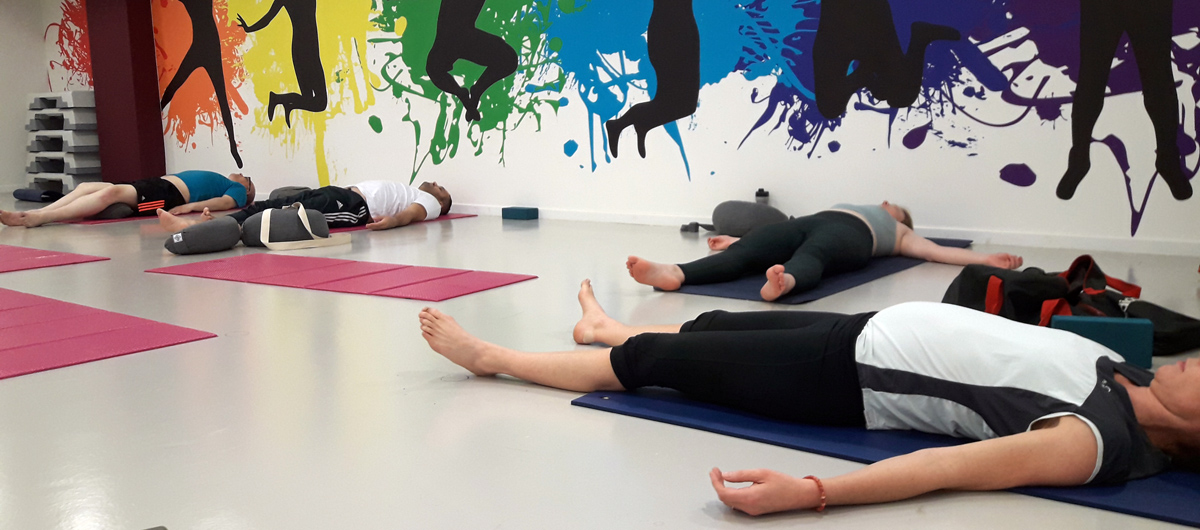
Putting overstimulation on hold
This personal testimony shows very clearly one of the facets of an afternoon yoga class at work. Much has to do with the impact of the nature of professional activities. Many employees find themselves in positions where outside requests and workloads are particularly erratic. This is accompanied by moments of acute overstimulation, which puts and keeps their mental levels in a state of fight, flight or freeze. Such a state is unsuitable for calm, strategic and creative planning or solution seeking.
So it comes down to getting into a different state mentally. And an hour of yoga is just perfect for that.
Returning to yourself
Living in this world inevitably presupposes interaction with the outside world. Energetically speaking, that interaction is healthy if it is balanced. That means you don’t give away more of your energy than you take back or receive. Let that be exactly one of the pitfalls in the modern office environment. Your energy goes where you focus your attention. And if you sit for eight hours permanently focused on permanently changing outside situations or screens with files that also exist outside yourself, then you are bleeding energy. One solution may be to take regular micro-breaks, aiming to bring your attention away from the outside back inside yourself. Take a slow and deep inhale, and then, exhale completely. Listen to how your body is feeling. Mindfully drink a glass of water or eat a healthy snack. Or you could do some mindful moving by stretching your limbs. And then your are ready to bring your attention and energy out again. In a never ending, swinging back-and-forth motion, like a pendulum. Those micro-breaks keeps your battery running smoother and longer, so to speak. Even in these situations, an hour of mindful yoga at noon has the function of a reset button.
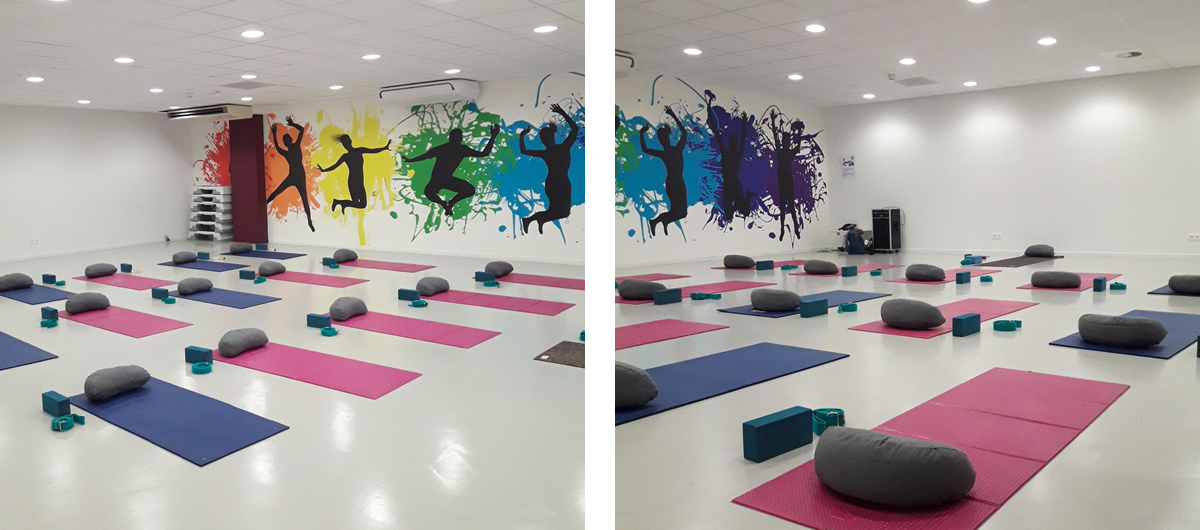
Is distraction a solution for those seeking relaxation?
It is a common misconception that if you are in need of relaxation, you can just seek some distraction. The whole social media and smartphones with their endless supply of apps and games online are floating on that false assumption as well as addiction mechanisms. All you achieve with aimless scrolling on your phone is that you just now addict your mind to overstimulation even more. It may not seem like it, but in fact you are fleeing from a situation, instead of facing it and just resting for a while and then resolving it purposefully and creatively. Because – again – you are giving away your attention, and thus your energy, to the voracious little screen of your phone.
No wonder you feel your energy drain and are left feeling empty.
Me-time is essential
A good strategy to rebalance and unwind your mental level is by purposefully moving to the level of your physical body with your attention and senses. By doing something purely physical, moving, taking deeper breaths. Actively and consciously engaging with the unique physical body in which we spend our lives on earth. After all, as human beings we are genetically programmed to function in a physical body. Entrepreneur Chloe Macintosh, who herself made a career jump and started doing more body-oriented work, put it very wisely in the following way in a podcast:
We humans are born in a body and we are also completely set up to function in a physical body. So if you don’t spend at least two hours every day consciously engaging with your body, why on earth did you come to this planet?”
Yoga is ideally suited for that shift towards the body . Because it combines three ingredients, three efforts: mental focus, breathing and physical activity. It blends them together into a unique and powerful mix that guides you into a totally different mental state after the practice. More calm, balanced and gentle than ever before.
Read more about yoga at the workplace
Check out the video and read about organizing yoga moments at work:
Do you feel like booking one of our classes?
Please use the links below to have a look at our offer and to book:
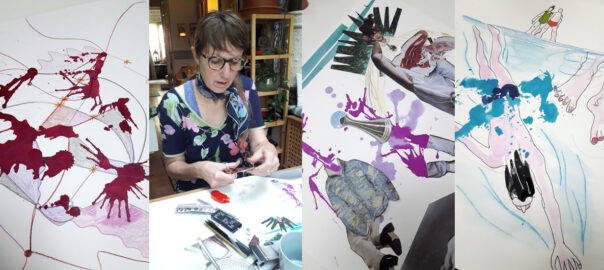
Every mistake is a gift
Failure does not exist
We were made to fear mistakes and imperfections in our childhood.
I still vividly remember how, at school in the first year of primary school, I suddenly saw a thick, dark blue ink stain fall from the old-fashioned hand pen onto the page … I let the thing dry, albeit too briefly, and then diligently started rubbing and sanding with the rough, blue side of an eraser, hoping the stain would go away. So that no one would see them, least of all the teacher. The result was even more blurry blue smudges AND a gaping hole in the sheet of paper. The teacher then used laundry pins to hang all the students’ calligraphy notebooks on a line for parent contact night. And mine hung open exactly on the page where the hole yawned …
Artists never fail
Artists know that mistakes don’t exist. That they are all necessary steps in the development of their work. Some artists work in the shadows for 20 years, searching and trying, while not being seen and not selling a single work. And then suddenly they change tack. New ideas and insights emerge and they sometimes radically change their style. And suddenly they are doing well artistically and commercially. So were all those earlier works and attempts failures? No, they were necessary to make the next step possible.
The potential of the stain
So in the sixth workshop “Yoga and the Art of Drawing”, we deliberately used the potential of the stain. Each participant was given a sheet of splattered paper, and asked to take the very spots on the blank paper as the starting point for their drawing, in complete freedom. Thus, the blemish on the paper became a component and even an inspiration for the creation. It once again gave rise to the most diverse drawings and collages.
The universe works in utmost perfection
Failures and mistakes are a life lesson. You can work around them or use them as strengths for the next phase. Perhaps I learned as a child in first grade, that the more you try to hide or erase something, the more visible it becomes. In our lives, there are also no mistakes, nor failures. Every event is perfection itself, at the right time and place. Provided you dare to look at them in a different way. Through your own eyes, and not through other people’s judgmental eyes. And then using them to your advantage, as a springboard to the next step.
In yoga philosophy, this corresponds to what is called yama and niyama in the eightfold path to enlightenment: the ability to free yourself from the yoke of:
- The (judgmental) gaze of others on yourself
- The (judgmental) view of yourself on yourself
Because only then do you create the conditions for true freedom to live your life according to your own unique plan.
How can I participate in a workshop with yoga and drawing myself?
Do you feel interest in yoga and the art of drawing workshops?
Would you like to get started with it?
Via the button below, you can read more about the format of the workshops and book your sessions:
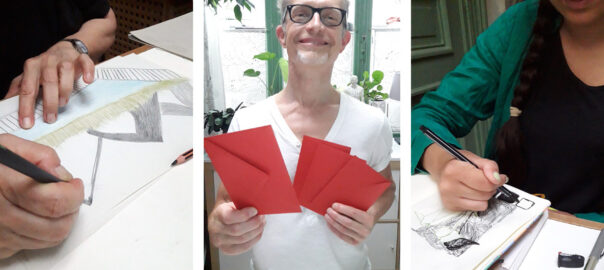
Intention is more important than result
Discover the why behind your drawing activity
Intention and yoga
When we practice yoga, the concept of intention is fundamental to our practice. First of all, we need to ask ourselves why we want to practice regularly. Is it initially out of curiosity? Is it because it is trendy? Or is it because deep inside us there is an almost naive and little-recognised belief that yoga is a magic pill or a simple box of magical tools that will – we hope very soon – solve a whole range of discomforts related to our existence?
If we practice yoga regularly, it is true that we concentrate and set in motion a lot of energy. It is a creative act. This energy can be consciously directed towards a more or less precise goal. Here are some examples:
- Maintaining, restoring or strengthening our physical body.
- To learn to calm our excessive mental activity or soothe our nervous system.
- In order to create an expansion of our consciousness.
- To adopt a more compassionate and benevolent attitude towards our lives, the other beings with whom we share existence on this planet and the world around us.
- Or to grow and develop and allow unsuspected aspects of our potential to blossom.
- To support our own healing or someone else’s.
- To live a life more grounded in our physical bodies.
Of course, this list is by no means exhaustive.
Just like asking yourself this question at the level of a regular practice, it is a good idea to choose a conscious intention at the beginning of each individual yoga session. To really get a grip on the reason behind your choice to sit on your mat for an hour, or even longer, instead of spending your time on another activity.
Intention and drawing
If you want to start drawing more regularly and consistently, it is also a good idea to ask yourself what you really want to do with this activity. Why am I drawing or creating? And what is my purpose?<:strong>
Is it to fill a void or dispel recurring boredom? Or to find more peace and relaxation in this creative flow of full presence that makes us forget any sense of the passage of time? Do we want to create images to brighten other people’s daily lives. Or do we have an activist goal to awaken people’s minds in the face of injustice, for instance? Is it to create objects of rare beauty? Or to touch deep emotional strings in our fellow humans? To come to terms with our own deeper emotions and feelings? Or to rediscover the joy and innocence of our childhood?
Whatever your reason and motivation, it is your intention – which you should examine carefully and remind yourself of regularly – that will help you sustain your creative activity through drawing in the long run.
Red envelope
As American designer Cat Bennett suggests in her book “Making Art a Practice – 30 Ways to Paint a Pipe”, you can write your intention on a sheet of paper, put it in a red envelope and tuck it under your bed’s mattress. In this way, we symbolically reinforce this written-down intention by keeping it in our body’s energy field during the night.
And it is a good idea to re-evaluate this original intention from time to time, because there may well be an evolution taking place that requires you to rephrase or clarify it. Nothing in this world is permanent except change.
How can I participate in a workshop with yoga and drawing myself?
Do you feel interest in yoga and the art of drawing workshops?
Would you like to get started with it?
Via the button below, you can read more about the format of the workshops and book your sessions:
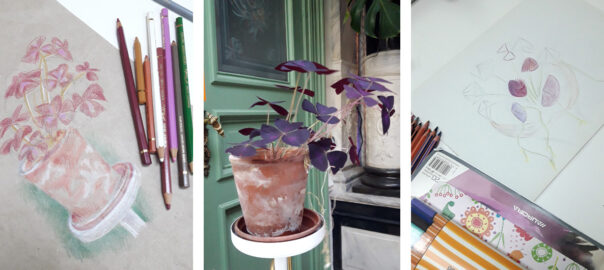
Awaken the observer in yourself
Neutral observation of reality
Both yoga and drawing push us towards better observation of reality. There are wonderful parallels between both these activities.
Yoga and objectivity
Yoga practice trains us to more easily assume the position of the observer in the world and in our daily lives.
And thus:
- We are less easily misled by our own thoughts, emotions, beliefs and judgements about the things around us.
- Moreover, we are able to perceive situations more neutrally. We recognise that different viewpoints and perspectives on the same phenomenon are possible.
- We soon understand that ours are almost always coloured. As if we are looking through tinted or smudged glasses.
This is often a big challenge.
Objectivity in artistic creation
Very often a drawing course starts with observational drawing.
In observational drawing, we also look for the most neutral representation of the subject of our drawing. The aim is to learn to see and reproduce it in an accurate and objective way. And this has several fascinating implications:
- it is amazing to see how different and distorted our representation of the model is compared to reality!
- We learn to adjust our gaze and make it more objective.
- We train the coordination of our vision and the motor skills of our hands.
- Soon, we discover our desire, often impatient, to proceed directly to a personal interpretation of the subject. And that is very different from a simple objective reproduction.
In any case, the drawing phase of observation is a useful phase that serves us well. Because it can improve the quality, intensity, thoroughness and depth of our gaze and our vision of things.
Much more than the ability to produce truly flawless classical drawings, it is these discoveries, about the relativity of our vision, that constitute the true, rich harvest of this kind of drawing activity.
How can I participate in a workshop with yoga and drawing myself?
Do you feel interest in yoga and the art of drawing workshops?
Would you like to get started with it?
Via the button below, you can read more about the format of the workshops and book your sessions:
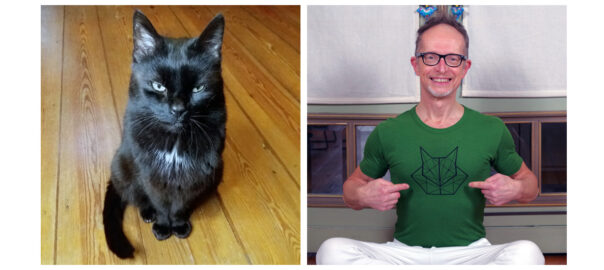
Why 108?
The fascinating magic of number 108
On the 22th of December 2022, which coincided with the winter solstice, I held a charity action in favour of the NPO Ever’y Cat, which is a Brussels-based NPO whose volunteer staff catches stray cats and gives them a better life in 4 Brussels municipalities, specifically: 1140 Evere, 1030 Schaarbeek, 1130 Haren and 1000 Brussels.
You can get a clear picture of exactly how they work on their webpage.
The action itself consisted of consecutively performing 108 sun salutations. Therefore it was akin to a “yoga marathon”, as crooked as that sounds. The action could be followed via social media platform Facebook and also attended via Zoom.
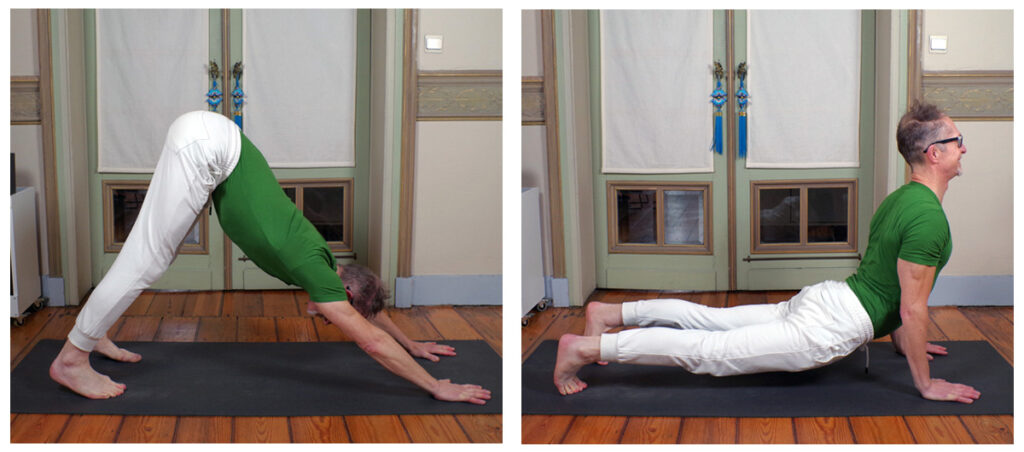
Why the sun salutation?
The sun salutation is pre-eminently a dynamic yoga exercise that puts a lot of energy in motion, energy that you can then spiritually direct towards a particular goal, in this case: the solidarity action with Ever’y Cat. The material precipitation of that energy is ultimately the money we collected, which is donated to the ASBL.
People also asked why exactly I did 108 sun salutations and not any other number.
What is the symbolic meaning of 108 ?
For a more detailed understanding and a concise summary of the symbolism and mystery of 108, I got clear information from professional astrologer and yoga therapist Susan Hopkinson. And this is what it boils down to:
The number 108 consists of three digits, each of which already has a special meaning in number science or numerology and in many esoteric philosophies of East and West:
- the 1 represents the all or “completeness”
- the 0 represents nothingness or the absence of energy, matter or existence: the “void”
- and the 8 in turn represents infinity
If you add 1 + 0 + 8 together, you arrive at the number 9.
Now, if you divide 108 by two, and then add the digits of the fraction again, you get 9 again.
Some examples:
-
- 108/2 = 54 and 5 + 4 = 9
- 108/4 = 27 and 2 + 7 = 9
- or: 108/8 = 13.5 and 1 + 3 + 5 = 9
- etcetera
Writers devoted entire volumes to the number 108.
9 Is considered a mysterious number in numerology, and it is said to “contain all teachings”.
Wherein lies the peculiarity of the number 9 ?
An example:
If you add to 9 another digit, you obtain a new number.
Now, if you add all the digits of that new number again, you get back the original digit. As if the 9 is capable of performing a great disappearing act.
Some examples here too:
- 9 + 5 = 14 and 1 + 4 = 5
- 9 + 8 = 17 and 1 + 7 = 8
- or : 9 + 1 = 10 and 1 + 0 = 1
How much did the action bring in?
Believe it or not, the action for Ever’y Cat raised 216.00 euros. That = 2 x 108. So each sun salutation raised 2.00 euros!
The money has been transferred in full to Ever’y Cat.
Many thanks to everyone who made a donation.
Read more about yoga and yoga classes in Schaerbeek:
Check out our yoga classes here:
View our full range of yoga classes
Read more about plant-based nutrition and health:
Check out more articles about nutrition, health and plant-based foods:
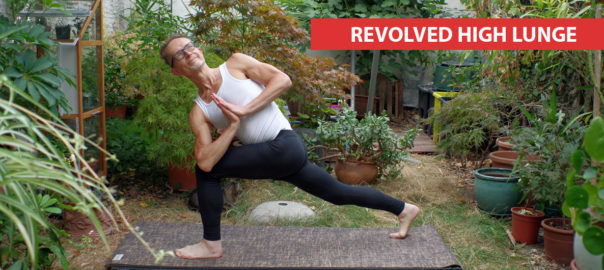
Stability when circumstances change
For the month of September, I chose the Revolved Praying Hero posture. In the more fitness oriented postural yoga, this one is also known as Revolved Lunge. The technical or Sanskrit name of this posture is Parivritta Namaskara Virasana. I deliberately do not use sanskrit terminology during yoga classes, because that is like giving a Catholic mass in Latin. And that is no longer of this time.
Sanskrit is good for the technical classification of postures or if you are studying or retraining in the Indian tradition.
Why does this posture fit so well with the month of September?
This posture fits well in this transitional season between summer and autumn. It is a yoga posture with a strong “grounding” character. Still, it is also “fiery”. It is a posture in which the earth element comes to the fore and the fire energy of summer can still be felt. It invites you to stand firm and stay in balance. That is exactly what we have to do now.
In the transitional periods between the four seasons, we are invited to make adjustments to our daily habits in order to keep our health in balance through the change of seasons.
This posture can be a good part of a sun salutation sequence.
Yoga influences and supports our well-being on all possible levels: physical, energetic, emotional, mental, spiritual.
See here how this posture affects all these levels:
Physical benefits
.
- Strengthening of the back, arms, ankles, legs, glutes
- Stabilizing and strengthening of the hip joints
- Opening and widening of the chest area
- Building and maintaining strength in the abdominal area
- Improving the mobility of the shoulders, shoulder blades and upper back
Energetic effects
- Activating and warming
- Stretching the kidney and liver meridians in the straightened rear leg, and of the gall bladder meridian in the side of the body
- Grounding of the feet and legs
- Stability and firmness in the lower chakras, space and release in the upper chakras
Emotional well-being
- Intensity
- Balance
- Staying calm in your own centre, even if conditions are challenging
- Stability
- Opening of the heart from a firm and balanced foundation
Mental attitude
- The ability to take several actions at once while staying focused
- Concentrated, clear and alert thinking
- Maintaining the balance between opposites
Spiritual growth
- A firm connection with the earth as a basis for development and liberation
Would you like to book one of our classes?
Have a look at our offer in yoga classes and book using the links here below:
Prana Yoga Flow
A full description of the basic postures of Prana Yoga Flow can be found in the book: “Prana Yoga Flow – Activate your life force, open your heart and live freely”, by Alberto Paganini. (Available in both dutch and english).
Alberto Paganini was one of my very first yoga teachers. You can find his website (in Dutch) here.
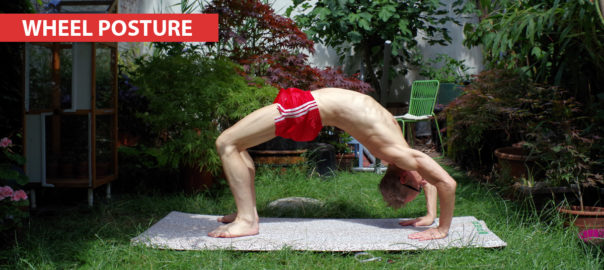
Embrace life with wheel posture
Our favourite posture for the month of July is the wheel posture. The technical or Sanskrit name of this wheel posture is Chakrasana or Urdhva Dhanurasana (Bow upwards). I deliberately do not use sanskrit terminology during the yoga classes I guide, because that feels like giving a Catholic mass in Latin.
Like the fish posture, this is also an opening pose, a variation of the backband. It opens and extends the front side of the body intensely.
Wheel posture is pre-eminently a posture that is somewhat easier to perform in the summer season, and somewhat more difficult in the winter. This is no coincidence. It is a yoga posture with a very “fiery” character, which strongly activates the solar plexus chakra.
It is one of the most intense postures in the Prana Yoga Flow. In our classes you will learn how to work towards it step by step.
Yoga influences and supports our well-being on all possible levels: physical, energetic, emotional, mental, spiritual.
See here how this posture affects all these levels:
Physical benefits
- Expanding the breathing capacity and strengthening the heart
- More space around and release of tension around the heart
- Strengthening of the back, arms, legs and buttocks
- Opening and expanding of the abdomen and chest
- Relaxation of the head and neck
- Improving the flexibility of the shoulders, shoulder blades and upper back
- Increased blood circulation in the whole body
- Prevention of heart and artery diseases
Energetic effects
- Activating and warming
- Stretching of the Ren Mai, stomach, heart and spleen meridians
- Grounding of the hands and feet
- Intense opening of all 7 chakras in the body
- Improved energy flow between the solar plexus and heart chakra
Emotional well-being
Mental attitude
- Improved sense of purpose
- More openness
- Concern for the positive and constructive
Spiritual growth
- Connection
- Powerful action with an open heart
- Joy of life
- Entrepreneurial spirit
- Healthy vigour
- Strong foundation
Would you like to book one of our classes?
Have a look at our offer in yoga classes and book using the links here below:
Prana Yoga Flow
A full description of the basic postures of Prana Yoga Flow can be found in the book: “Prana Yoga Flow – Activate your life force, open your heart and live freely”, by Alberto Paganini. (Available in both dutch and english).
Alberto Paganini was one of my very first yoga teachers. You can find his website (in Dutch) here.
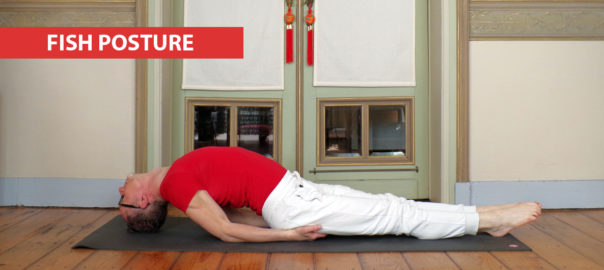
Open your heart with Fish posture
Our posture for the month of May is Fish Posture, or Matsyasana.
Excellent to practice right after candle and/or plough posture, as it helps to rebalance the neck.
See how this posture supports us on so many different levels:
Physical
- Deepening of the breath
- More space and release of tension around the heart
- Strengthening of the upper back
- Stimulation of the thyroid and thymus glands
- Deep stretch of the neck and jaw muscles as well as the throat
Energetical
- It improves the energy flow between solar plexus, heart- and throatchakra.
- Stretching of the Ren Mai and Bladder meridian on the trunc
- Stretching of the Stomach and Liver meridians in the legs (when performed with legs in tailor posture or lotus posture)
Emotional
- Cultivation of Joy and Hope.
- Counteracts depression and fearful reticence
Mental
- Helps to bring on and keep a positive, optimistic and inspiring attitude to life
Spiritual
- To engage with life with an open and trustful attitude
- Courage
- Hope
- Love of Freedom
- Selfless Love
- Compassion
- Kindness
- Purity
- Helps to develop the Heart chakra awareness.
Want to book one of our classes? Check out the calendar via the button below:
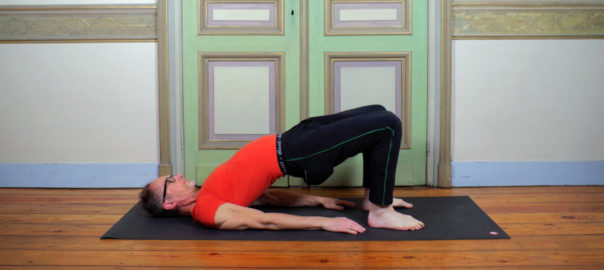
Good care for your back
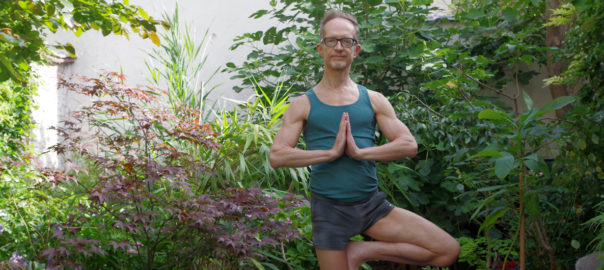
Group class and daily practice
You can attend as many group classes as you like. There are two facts you cannot ignore:.
- Yoga postures were originally intended as a preparation for (daily) meditation.
- Yoga was originally conceived as an individual, daily discipline.
Group classes or no group classes
Even though I like to teach group classes a lot, the finality of a group class is that they cancels themselves out at a certain point. That happens when you manage to create and maintain the discipline of a yoga moment at home on your own every day and make it to a daily ritual.
Only then does it make sense to take group classes.
But I myself also started my discovery of yoga through group classes in my former work environment. In a group class you acquire a good basis. From each yoga teacher you carry pieces of valuable knowledge with you. Group practice also has a unique, special energy and atmosphere that many people love. Especially people who need to be close to other people.
Group classes are also a simplification. Because every body, every soul, every mind, every individual human being is different. A group class cannot possibly fulfil all the individual needs of the moment. Even if the yoga instructors do their best, a group class will remain a “middle of the road” approach.
Those who practice yoga alone at home can make it a highly individual event, followed by a daily meditation practice that is also tailor-made.
Morning yoga
I myself practice yoga for 20-30 minutes maximum in the morning, before meditating for 20-30 minutes. This morning yoga completely changes the energy of my day. It also helps to get rid of the morning stiffness. Afterwards, I can meditate quietly whilst experiencing my body in a pleasant way. Or rather, I hardly feel my body at all. So I can meditate all the better on a mental level.
Some exercises, such as balancing on one leg, are much easier to me in the morning than in the evening. I have atypically shaped feet which give little support, making these postures an extra challenge. In the evening, when I have already been through the wringer of a very active day, I am much more wobbly than in the morning. This wobbling also happens during the group lessons in the evening. Then I am no longer “the yoga teacher who demonstrates the posture to perfection”. And I am fine with that.
Level one
You practice yoga for yourself, with yourself. With the body you have. And that body is different every day, it changes in time, because nothing is permanent. Yoga is therefore an exercise in changeability. And in accepting imperfection. The atypical foot. The occasional wobbling. One shoulder lower than the other. The somewhat crooked spine. It’s not about the perfect alignment, the flawlessly held pose or the aesthetic result.
Physical yoga practice is level one meditation. It means going through a physical and energetic experience that makes you aware. It is about becoming aware of your physical body and your vital energy.
